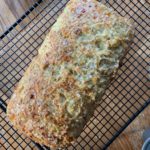
Dill Bread
Servings 1 loaf
Ingredients
- 1 package active dry yeast
- 1/2 teaspoon sugar
- 1/4 cup warm water
- 1 cup small curd cottage cheese
- 2 tablespoons sugar
- 1 tablespoon melted butter
- 1 tablespoon Minced dried onions
- 2 teaspoons dried dill seed
- 1 teaspoon dried dill weed
- 1 teaspoon salt
- 1/4 teaspoon baking soda
- 1 egg beaten
- 2 1/4 cups all-purpose flour
- butter for brushing on baked loaves
- coarse sea salt for sprinkling
Instructions
- Dissolve yeast and sugar in the warm water. Let it sit for 10 minutes until the foam on top is doubled in size.
- Heat the cottage cheese in a small pan to lukewarm.
- Combine the cottage cheese and the yeast mixture together.
- Add the remaining ingredients until combined.
- Butter a large bowl and place the dill bread dough. Roll the dough around the bowl to butter it.
- Place a dish towel over the bowl and set it in a warm place (microwave works great). Let the dough rise for about one hour or until it is doubled in size.
- Press the dough down and shape it into either one regular loaf size or three mini loaves.
- Place the shaped dough into the loaf pan(s). And again set them in a warm place, cover them with a dish towel and let them rise for another hour or until doubled in size.
- While the dough is rising for the second time preheat the oven to 350°F.
- Bake the regular sized loaf for 40-45 minutes or until golden brown. Bake the mini loaves for 25-30 minutes.
- Take out of the oven and let sit for no longer than 5 minutes in the pan(s). Remove the bread from the pan(s) and set them on a wire cooling rack.
- Brush lots of butter on the top and sides of the loaves. Sprinkle with coarse sea salt.
Notes
From: Linger a Little
- Place the yeast mixture in a warm place (microwave works great) and let it sit for about 10 minutes or until the foam on top has doubled in size.
- If the yeast does not rise, it’s because the water was too hot or the yeast is old. If that’s the case, you will need to start over with new yeast. You don’t want the dough to rise beyond double because it stretches the gluten too much and will cause the end product to be tough.
- How can you tell if your dough has risen to its proper stage? Use the tip of your finger and make an indentation around the outside of the dough. If it bounces back about halfway, you know your dough is ready.
- Don’t let the baked loaves sit any longer than five minutes in the pan, otherwise, they sweat and produce condensation.